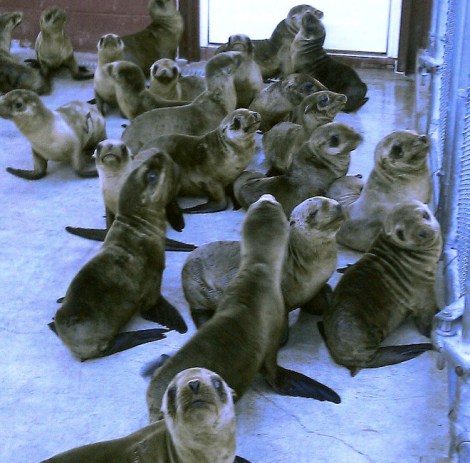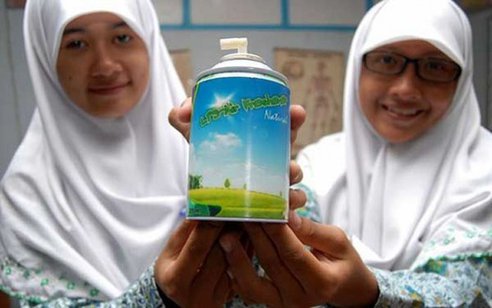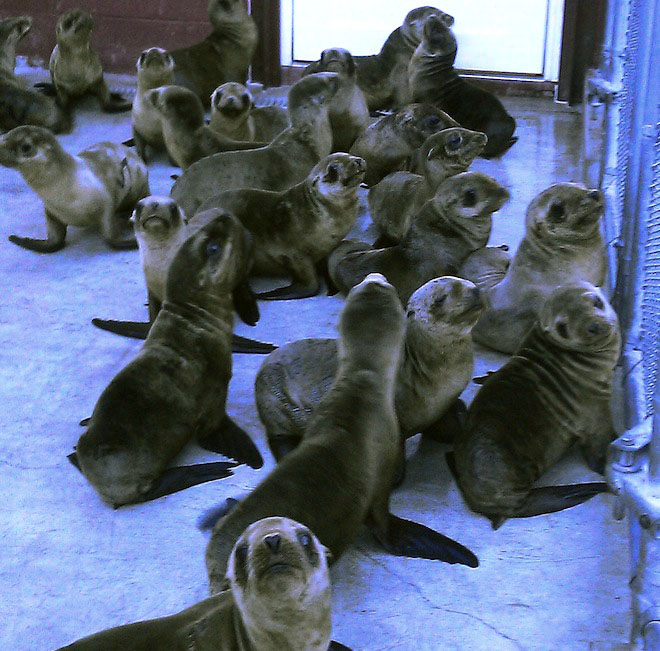
Pacific Marine Mammal Center
Less than three months into 2013, 517 stranded sea lion pups have already been admitted to rescue centers in southern California. That’s higher than the total for some full years. What the hell is going on? Why are so many dehydrated and malnourished baby sea lions washing ashore? And do they need us to take some of them home?
Right now, the San Pedro facility is caring for more than 100 pups. Down the coast, the Pacific Marine Mammal Center has more than 90. On Mar. 12, that facility declared a state of emergency after 18 rescues over two days threatened to overwhelm existing resources. Farther south in San Diego, SeaWorld reports more than 140 marine mammal rescues this year, the majority of which are California sea lions. In all of 2012, SeaWorld rescued 131 marine mammals.
Most of the stranded pups are about nine months old, and they weigh half as much as a sea lion that age should weigh. Rescue centers are trying to feed, rehydrate, rehabilitate, and release them, but new pups are coming in as fast as they can help the old ones — and some of them, 20 or 30 percent, are too far gone to be saved. Worse, we haven’t even hit the typical peak stranding season yet.
This would all be more normal after a strong El Niño, which tends to increase sea lion pup mortality because warmer water affects the food supply. But this isn’t an El Niño year. So what gives? Scientists have some guesses — hookworm, infectious disease, a brief spell of El Niño-warm water last summer — but they’re all just guesses, and none of them seem all that likely. The most convincing explanation is that something is badly cattywampus in the sea lions’ ecosystem:
“Sea lions are usually pretty good at adapting,” Melin said, noting that biologists often monitor female sea lions and use them as a gauge of ecosystem health. “If the system starts changing or becomes out of whack, they’re the one that are going to show the signs.”
There are other hints that something more systemic is amiss in the Islands, namely the nesting numbers and success of brown pelicans in the Channel Islands National Park. Pelicans, like sea lions, are top predators. Both species tend to forage for the same fish, and their numbers tend to fluctuate in tandem. In 2004 and 2005, pelicans in the islands made roughly 6,500 nest attempts, said seabird biologist Laurie Harvey of the California Institute of Environmental Studies. Last year, out of several hundred nest attempts, only five pelican chicks fledged on Anacapa Island. “That ended up being the poorest reproduction year for pelicans on the Channel Islands since 1970,” she said.
No matter how hard rescue organizations hustle to save the washed-up pups, if this is a systemic problem, fattening up an individual sea lion pup — or even hundreds of them — isn’t going to address the root cause. In the meantime, though, rest assured that brave animal rescuers are plucking these sad babies out from under trucks and inside flowerpots where they’ve washed up, and nursing them back to health as well as they can. So at least there’s some good news. Well, 70 to 80 percent good.



